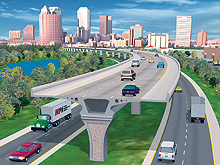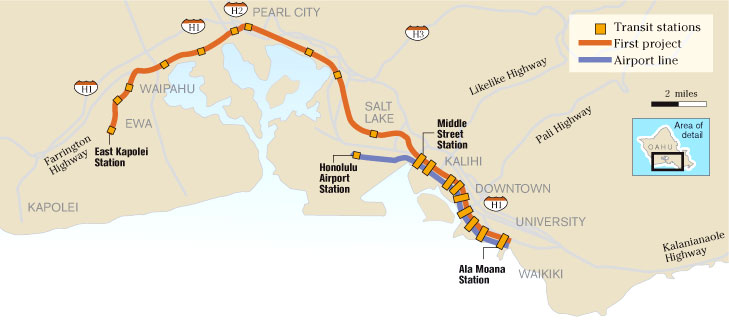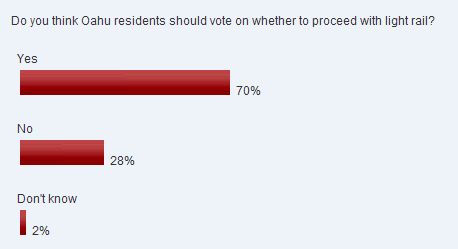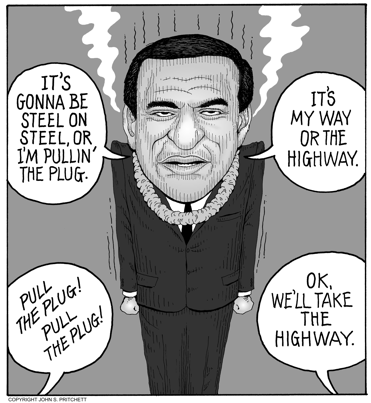
honolulutraffic.com
Offering cost-effective ways to reduce traffic congestion in Honolulu
![]() May 28, 2008.
May 28, 2008.
The alternatives to rail defined:
We are getting a little tired of the Mayor telling voters that he doesn't know any alternatives to rail. The fact is that it is the Managed Lane Alternative, which are High Occupancy Toll Lanes with priority given to Bus/Rapid Transit — HOT BRT — and he knows it.
In the 2006 Alternatives Analysis, the Mayor persuaded his "client-focused" consultants, Parsons Brinckerhoff, to put an absurd projected cost of $2.6 billion on the HOT lanes despite the Tampa Expressway having just opened at a cost of only $320 million.
We have recently done more work with the help of our friends in Florida and are now convinced that HOT BRT can be built for less than our original estimate of $900 million.
Here's our revised plan, the HOT BRT Alternative, which includes a discussion of revised costs.
![]() May 24, 2008.
May 24, 2008.
Airport back in the rail plan, but how?
According the today's newspapers, the Mayor is planning a $350 million airport link as shown on the map below. The questions it raises are:
First, if the rail line is presently maxed out at a train every three minutes during the peak hours, how are they going to be able to run a separate train in-between those regular trains? You certainly cannot run a train every 90 seconds; that is not doable.
Are they instead not going to have a separate Airport train but rather that you merely transfer from one of regular trains at the Middle Street Station and change for the Airport Station? They would build a $350 million line just for that? When passengers will have to change to another shuttle anyway when they get to the Airport Station?
For just two miles it would make more sense to have a bus shuttle from Middle Street directly into the Airport. Why am I even raising the issue about "sense" when we have not seen any evidence of it at all so far in this project?
The second issue is, who is going to take the train to the airport? Certainly very few visitors since they are here with large bags, which will undoubtedly not be allowed, not local folks going to the airport with large bags? And we do not have the kind of businesspeople coming into town with an overnighter bag to be leaving the following day as you see in many Mainland cities. The City will come up with some projection showing that hordes of people will use the rail extension. We'll see.
It seems to us that our newspaper reporters might have asked more questions of the city.

![]() May 21, 2008.
May 21, 2008.
Transportation funding crisis spreads to cities:
Two years ago Dr. Martin Wachs, who heads the Rand Corporation's transportation practice, wrote A Quiet Crisis in Transportation Finance, a 24-page narrative on what has led to the crisis and what action could be taken by various local, state and federal authorities. He concluded:
"As the joint federal and state commitment to building the great Interstate Highway System has been replaced by a more scattershot program of highway system maintenance, limited capacity expansion, environmental mitigation, and alternative travel modes, federal transportation leadership has faltered. In each of the post-Interstate transportation bills passed since 1990, the number of special funding categories has increased, while the number of earmarked projects has skyrocketed (to more than 6,300 in the 2005 legislation). Many of these projects would not survive the benefit/cost scrutiny to which program-funded projects are typically subjected.
In addition, the “strings” attached to federal matching grants, in the form of procedural and environmental rules and regulations, have increased over the years, while the relative federal contributions of highway revenues and public transit subsidies have fallen. This, in no small part, has led to the rise of county transportation taxes and transportation agencies described above. So while the federal government remains today the central player in surface transportation planning and finance, the federal program is far less focused, and less compelling, than it once was.
We are thus in a difficult situation to be sure, but not an irresolvable one. There are a wide variety of public policies available that elected officials – at the federal, state, and local levels – can use to address the chronic cost/revenue squeeze in transportation finance. These include greater reliance on borrowing, shifts to alternative forms of user fees, such as electronic tolls or mileage based charges, greater reliance on general taxes and fees that are not directly linked to use of the transportation system, or some combination of these approaches. Forging consensus on who should pay for transportation systems, and how they should pay, will be necessary to avoid a prolonged period of instability and crisis in American transportation finance."
It is now two years later and little has happened.
A recent article in U.S. News and World Report, Mass Transit Systems Have a Hard Time Paying the Bills, details what is happening to various transit agencies across the nation.
This is an issue that our elected officials should study carefully before committing themselves to any massive rail lines.
![]() May 18, 2008.
May 18, 2008.
Rick Hamada Show every Monday for transit debate:
Starting last Monday and continuing every subsequent Monday from 7:00 to 8:00 AM, Rick Hamada will host a debate/discussion between rail proponents and proponents of Express buses on HOT lanes. Tomorrow morning, May 19, will be Steve Hogan of Parsons Brinckerhoff and Cliff Slater of Honolulutraffic.com.
Click here for the podcast for last Monday with Dr. Panos Prevedouros and Steve Hogan.
Advertiser: David Shapiro's thought for the day:
From yesterday's Advertiser: "City Council members Rod Tam and Ann Kobayashi want to ban homeless people from hanging out at bus stops. What are they supposed to do for transitional housing until the rail stations are built?"
![]() May 14, 2008.
May 14, 2008.
Reason: "Public Prefers Tolling to New Taxes":
The April issue of Reason Foundation's Surface Transportation Innovations suggests that there is robust support for tolling:
"There’s a wealth of survey data suggesting that the public would rather pay tolls for new highway capacity than have their gas taxes increased. That’s a principal finding of an important new synthesis report from the National Cooperative Highway Research Program of the Transportation Research Board. The report (NCHRP Project 20-05, Synthesis Topic 38-03) is due out later this month (or early next month) and should be downloadable soon from the TRB website (www.trb.org). You can get a preview from an article by co-author Johanna Zmud in the Winter 2008 issue of Tollways, the quarterly from the International Bridge, Tunnel & Turnpike Association (www.ibtta.org/files/PDFs/win08_Zmud.pdf).
"The research project examined 110 U.S. public opinion studies on some aspect of tolling or road pricing carried out over the past 10 years. Most of the surveys had large enough sample sizes to be useful and were carried out in a scientific manner. Some very interesting results emerged. For example, if respondent pool consisted of “potential users,” support for tolling or pricing trounced opposition by 74% to 15%. Using “registered voters” as the sample, tolling support was almost the same: 71% vs. 24% opposed. But if the survey targeted the “general public,” the pro and anti-toll position tied at 42% each. Another strong finding was that surveys based on a specific project showed far higher support for tolling than surveys posing a general question about tolling or pricing—62% support if project-specific versus 38% if a general question."
See the links above for further details.
![]() May 8, 2008.
May 8, 2008.
City lists $108 million in contracts for rail:
The list of contractors and the amounts of their contracts shows that a significant amount of it is for what the city euphemistically calls "outreach," but which in reality is pure hard sell. Examples are $120,000 for former Secretary of Transportation Mineta, $500,000 for local flack Elisa Yadao, Pat Lee $216,000, the ever charming John DeSoto $150,000 and so on. Any insider information that you have about those on the list will be most welcome.
City produces maps of proposed rail stations:
The maps show an overall map of all stations and the other link is to detailed maps of each station.
Council fends off attempt to kill technology bills:
The four pro-rail councilmembers, Garcia, Apo, Okino and Tam attempted to have new Bills 36 and 38, relating to transit technology, "filed," which means they would not be referred to the Transportation Committee as is usually routinely done. The other five councilmembers opposed that move and defeated the attempt by votes of 5-4.
![]() May 7, 2008.
May 7, 2008.
Larry Price warns officials that the initiative is serious:
In today's MidWeek, Larry Price's the Price is Right column for this week is titled, "Ready For A Rail Referendum." The most important paragraph is the final one where he says:
"The 'Stop the Rail' movement has the ubiquity of Internet access and information technology on its side, and there is no question the public is now more connected than ever before and firmly believes their wishes are not being addressed by arrogant elected officials. Said another way, they have few practical hurdles before them they cannot clear with ease. Their real obstacles are mental ones. Our governmental officials would be well-advised to consider this referendum worthy of their utmost attention."
![]() May 6, 2008.
May 6, 2008.
Council meets tomorrow on transit:
The City Council meets tomorrow morning, Wednesday, May 7 at 10:00 AM to discuss among other matters, the creation of a Transit Authority, and Bills 36 & 38 relating to transit technology. One is for "rubber tire on concrete" and the other "rubber tire and maglev."
COMMENT: "Benefits" of rail change over time:
First they shouted at their rallies, “Traffic Sucks!” and
that we had to reduce traffic congestion and so we needed rail. When we pointed
out that their own studies showed that traffic congestion would be far worse
with rail, they changed gears.
They said OK, it will not improve congestion, but it will give people a choice. When in time the public didn’t buy that, they moved on to development.
They said the major advantage of rail was that it would allow us to build transit-oriented developments (TODs) around most of the stations. Now that it is revealed that all TODs require heavy subsidies to make their “vibrant, walkable, live and work” neighborhoods palatable to buyers, they are changing emphasis to “it will provide jobs in this poor economic environment.”
The fact is that the federal funds will not come close to funding all the items that must be purchased offshore. This covers trains, steel rail lines, escalators, elevators, electrical sub-stations, computers and the myriad pieces of equipment that go into furnishing a rail transit system. What remains of our local funds will go construct a totally uneconomic rail transit system.
It seems to us that we can accomplish providing the jobs by just paying the workers. At least that way we will not be building something that will create heavy annual losses.
In writing this, we are reminded of Houston businessman Bob Lanier who opposed rail transit in 1990. He was elected Mayor replacing the pro-rail Mayor Kathy Whitmire.
He said about rail: “First they say, `It's cheaper.' When you show it costs more, they say, ` It's faster.' When you show it's slower, they say, `It serves more riders.' When you show there are fewer riders, they say, `It brings economic development.'When you show no economic development, they say, `It helps the image.'When you say you don't want to spend that much money on image, they say, `It will solve the pollution problem.' When you show it won't help pollution, they say, finally, `It will take time. You’ll see.” From the Houston Metropolitan Magazine, November 1990, page 49.
![]() May 5, 2008.
May 5, 2008.
Our comments on the city’s latest spin:
The city has posted what it says are the “TOP 5 REASONS FOR RAIL” on its website. We have responded with our comments on it and the comments include the city's top 5 reasons in full.
The best indicator that rail transit is a poor choice is that the City has to spin, obfuscate and toy with the truth trying to drum up support for it.
When they behave this way they essentially concede that our transit proposal, HOT BRT, or Express Buses on HOT Lanes, is superior to rail. Otherwise they would merely state the truth about both projects.
We believe that an even handed comparison between HOT BRT and rail transit would show that HOT BRT can carry more people, is twice as fast, is far less costly and offers greatly reduced traffic congestion.
It is important that the city's "reasons" and our "comments" be read to understand how the city is spinning their story.
![]() May 4, 2008.
May 4, 2008.
And this is all legal?:
The Advertiser's Sean Hao has a story today headlined, "Transit firms backing Mayor: Contractors have contributed $163,000 towards his re-election." Here are three excerpts from this story; see if this sounds legal to you:
Companies with city contracts [such as PB] are banned from contributing to city political campaigns. …
$16,750 came from Parsons Brinckerhoff employees with out-of-state addresses…
"We have an interest in supporting transit and supporting those people that we believe are strong
advocates for infrastructure in general," said Parsons Brinckerhoff spokeswoman Judy Cooper.
John Pritchett's "A Hawaiian Sense of Place."
![]() May 3, 2008.
May 3, 2008.
Please welcome another 35 new members:
Mike Fuller Robert Kay Bob Briggs Pat Sylva Barbara Nakamura
James Wiedman James Leith Paula Boyce Brett Kurashige
Catherine Robinson Charles Gill Chester Lau Albert Canon
Eve Leith John Rogers Joyel Horita Mark Webster Matt Reynolds
Mark Myer Sean Nichol Janice Pechauer Michael Lee Gerhard Hamm
Alice Silva William Crowe Ellie Crowe Jan O'Donnell Talifaitasi Satele
Warren Woodward Talk Story Magazine, Inc. George Berish Ethan Boone
Caryl Joy Campbell Susii Hearst Leonard Franzen
Today's Star-Bulletin carries op/ed on HOT lanes cost:
Today's SB carries an op/ed by Cliff Slater, City glossed over truth about cost of HOT lanes ,which deals with the completely exaggerated cost projected by the City for constructing HOT lanes.
We also have posted his Star-Bulletin op/ed of March 30, Transit-oriented development not a panacea for our communities which we had forgotten to cover at the time. In it he points out that, "the public does not generally value the "higher density, vibrant neighborhood" features of TODs. We know that because home buyers and retailers will not pay the full costs of the apartments, houses and shops that have been built. To make them saleable, taxpayers have had to provide heavy subsidies.
"TODs are now often being touted as a major reason for building rail transit even though there are no TODs that are not heavily subsidized. Are our planners and elected officials proposing heavily subsidizing rail transit in order to heavily subsidize TODs? You gotta love the way these folks think."
Not that old General Motors myth again:
Every so often the old myth about General Motors destroying the U.S. streetcar system is trotted out and once more we have to write a rebuttal. Yesterday's Star-Bulletin carried the following letter under the heading "Don't let auto lobby derail another train":
"It is beyond belief that some are acting outraged at the "radical idea" of rail here. Early in the last century we had trains, streetcars and ferries running all over the San Francisco Bay area and down to San Jose. It was simple and cheap to get around. After the war, General Motors, et al, changed all that with their scheme to sell buses everywhere. The same happened in Los Angeles, which had Red Trains running far and wide and were destroyed. Look at LA. now.
San Diego was smart enough to build a beautiful rail system, which runs from suburbs to the north to the Mexican border. We must not listen to the naysayers here who would cripple us. In the past we had a train that ran out to Haleiwa, but we let the auto industry kill that, too. Nancy Bey Little, Honolulu."
The real facts are that starting around 1920, before General Motors ever got near the bus business, cities began dismantling streetcar systems in favor of buses. It began with the smaller cities and continued over 40 years. Honolulu began dismantling its streetcars in 1933. The Advertiser said at the time, “Honolulu is doing what all progressive mainland communities are nowadays doing: getting rid of streetcars and replacing them with good-size buses...we certainly will finally progress to the point of abolishing streetcar tracks. And that will certainly be a vast improvement.”
Three weeks later, the Japanese language Hawaii Hochi agreed, stating that buses, “are vastly better than the rattle-trap, clanging streetcars. Instead of an ordeal to be dreaded, a ride in these buses is an enjoyable, restful experience."
By 1941 Honolulu had finished replacing its streetcars and become an all-bus city; none of the buses were from GM, they were all Twin Coaches. For more detail, read General Motors and the Demise of Streetcars.
![]() May 2, 2008.
May 2, 2008.
Today's PBN Survey results show 70% want to vote:


Last Monday's Schneider v. Slater podcast:
On the Rick Hamada Show last Monday the whole hour from 7:00 AM to 8:00 AM was spent debating the rail issue. It was between Mike Schneider, Managing Partner of InfraConsult LLC, and former Executive VP of PB Consult, the consulting arm of Parsons Brinckerhoff, and Cliff Slater, Chair of Honolulutraffic.com. Fortunately it was during Rick Hamada's podcast hour.
Rail as a Quality of Life issue:
The Mayor keeps telling us that we need rail because it is about our Quality of Life. This short video clip demonstrates the relationship between rail transit in Hawaii and Quality of Life.
Promises, promises, promises, promises:
